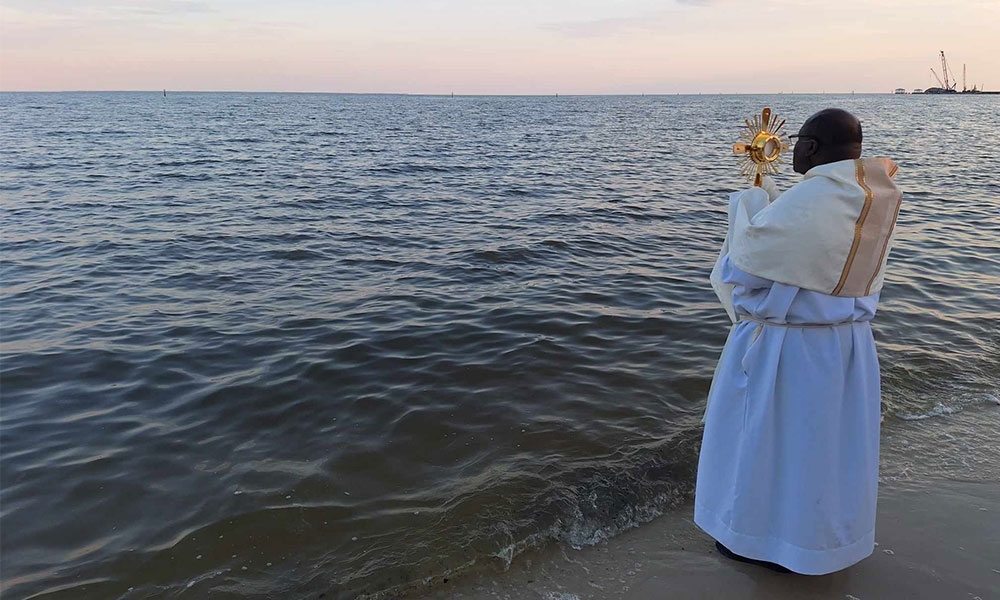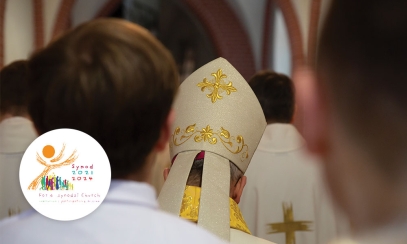
Christ Among Us
The National Eucharistic Pilgrimage
The National Eucharistic Pilgrimage
Worship - Adoration - Fellowship
Worship - Adoration - Fellowship
The National Eucharistic Pilgrimage, which preceded the Eucharistic Congress, began on Pentecost Sunday in four different regions of the U.S. From north to south and east to west, Catholics joined Jesus in the Eucharist in the journey toward Indianapolis.
All of the faithful were invited to take part in this pilgrimage – by joining Eucharistic processions as they made their way through towns, participating in Eucharistic adoration or taking part in the Eucharistic liturgy at designated stops. Worship, adoration and fellowship were the cornerstones of this national pilgrimage, enabling the Eucharistic revival that has swept the country.
Thirty young adults known as Perpetual Pilgrims traveled full-time from May until July, accompanying the Real Presence and serving those in need at stops along the way. Through sometimes rough terrains and scorching temperatures, the faithful joined together as the Body of Christ to publicly witness that Jesus is alive and present with us in the Eucharist.
FROM THE NORTH:
Marian Route
Named in honor of its visit to the National Shrine of Our Lady of Champion – the site of the first and only approved Marian apparition in the U.S. – the Marian route began in Minnesota, passed through Wisconsin and followed along the shores of Lake Michigan.
On May 27, a crowd of 7,000 – the largest procession among the four routes – traveled 4.5 miles starting at St. Paul Seminary and continued until the Eucharist arrived at the Cathedral of St. Paul.
FROM THE WEST:
St. Junipero Serra Route
The longest and most challenging route of the pilgrimage spanned 2,200 miles beginning on the Pacific coast. It proceeded across Lake Tahoe and the Rocky Mountains before hitting the Great Plains of Nebraska. The route was named after the “Apostle of California” – missionary priest St. Junipero Serra.
Parishioners of all ages became pilgrims along many stops at parishes and other venues for Eucharistic processions, adoration, Masses and youth events. In St. Louis, pilgrims distributed “Boxes of Mercy” to refugee families.
FROM THE SOUTH:
St. Juan Diego Route
Named after the Mexican saint who received visions from Our Lady of Guadalupe, pilgrims of the St. Juan Diego Route braved record-setting heat that did not deter this southernmost route of the pilgrimage. The route wound its way around the Gulf of Mexico before turning north in Alabama, wandering through Atlanta, Nashville and rural Kentucky.
On June 28, more than 1,000 processed through downtown Nashville. Dominican nuns and children tossed flower petals on the ground before the Eucharist passed through the streets.
FROM THE EAST:
St. Elizabeth Ann Seton Route
The 1,100-mile eastern route was named in honor of the first American-born saint, St. Elizabeth Ann Seton. It began on the Atlantic Coast, crossing the Appalachian Mountains and traversing through Ohio.
On Memorial Day, Cardinal Timothy Dolan carried the Blessed Sacrament by boat to the Statue of Liberty and offered a blessing there. The Seton Route brought Christ to the incarcerated at Pickaway Correctional Institution in Orient, Ohio, on June 28, allowing 35 imprisoned men to attend Mass and 25 to participate in the Eucharistic procession afterward.
Quick Facts
May 18 - July 17, 2024
4 Routes
60 Days on the Road
1,000 Hosts
6,500 Miles Traveled
100,000 Participants


